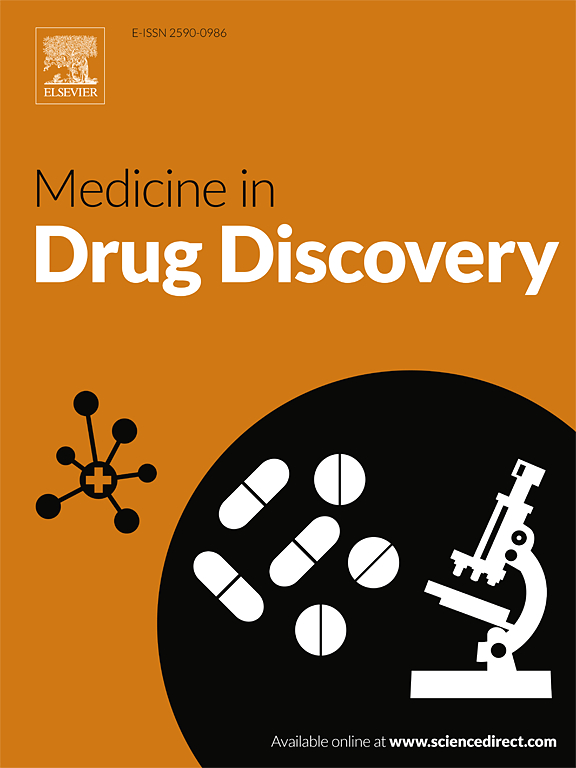Repositioning of rhodanine-thiazole hybrids as aldose reductase inhibitors
Q2 Medicine
引用次数: 0
Abstract
This study investigates the aldose reductase (AR) inhibitory potential of a series of synthesized rhodanine-thiazole hybrids (7a–7 l) through a combination of biological assays and computational modeling. The derivatives were divided into two categories: rhodanine (7a–7f) and rhodanine acetic acid derivatives (7g–7l). Biological evaluation revealed that rhodanine acetic acid derivatives demonstrated superior AR inhibition, with IC50 values ranging from 6.87 to 9.07 µM, compared to rhodanine derivatives (11.79–15.90 µM). Among them, compound 7i (4-fluoro rhodanine acetic acid) exhibited the highest potency (IC50 = 6.87 ± 1.22 µM), outperforming the standard Quercetin. Kinetic studies confirmed 7i as a reversible, non-competitive inhibitor (Ki = 6.87 µM), indicating interaction at an allosteric site of AR. Molecular docking using Schrödinger’s Glide XP mode against AKR1B1 (PDB ID: 4JIR) revealed that 7i had the most favorable docking score (−10.02) and binding energy (−67.51 kcal/mol), surpassing the standard inhibitor Epalrestat. Molecular dynamics simulations (200 ns) for 7 h and 7i indicated stable binding within the active site, with TRP111 identified as a key interacting residue. Interaction profiling revealed consistent hydrogen bonding and hydrophobic interactions, especially for 7i. Further, Principal Component Analysis (PCA) and Free Energy Landscape (FEL) analysis confirmed the stability of the 7i-bound complex, showing a dominant low-energy conformation. Dynamic Cross-Correlation Matrix (DCCM) analysis suggested that 7i enhances protein stability by modulating internal dynamics. Overall, 7i emerges as a promising AR inhibitor with potential therapeutic relevance for diabetic complications.
罗丹宁-噻唑杂交种醛糖还原酶抑制剂的重新定位
本研究通过生物实验和计算模型相结合的方法研究了一系列合成的罗丹宁-噻唑杂交种(7a - 7l)的醛糖还原酶(AR)抑制潜力。衍生物分为罗丹宁(7a-7f)和罗丹宁乙酸衍生物(7g-7l)两类。生物学评价显示,罗丹宁乙酸衍生物的IC50值为6.87 ~ 9.07µM,优于罗丹宁衍生物(11.79 ~ 15.90µM)。其中化合物7i(4-氟罗丹宁乙酸)效价最高(IC50 = 6.87±1.22µM),优于标准槲皮素。动力学研究证实7i是一种可逆的非竞争性抑制剂(Ki = 6.87µM),表明在AR的变抗位点发生相互作用。利用Schrödinger的Glide XP模式对AKR1B1 (PDB ID: 4JIR)进行分子对接,7i具有最有利的对接评分(- 10.02)和结合能(- 67.51 kcal/mol),超过了标准抑制剂Epalrestat。分子动力学模拟(200 ns) 7 h和7i表明在活性位点内稳定结合,TRP111被鉴定为关键的相互作用残基。相互作用谱显示了一致的氢键和疏水相互作用,尤其是7i。主成分分析(PCA)和自由能分析(FEL)进一步证实了7i键配合物的稳定性,显示出主要的低能构象。动态相互关联矩阵(DCCM)分析表明,7i通过调节内部动态来增强蛋白质的稳定性。总之,7i是一种很有前景的AR抑制剂,对糖尿病并发症具有潜在的治疗意义。
本文章由计算机程序翻译,如有差异,请以英文原文为准。
求助全文
约1分钟内获得全文
求助全文
来源期刊

Medicine in Drug Discovery
Medicine-Pharmacology (medical)
CiteScore
8.30
自引率
0.00%
发文量
30
审稿时长
21 days
期刊介绍:
 求助内容:
求助内容: 应助结果提醒方式:
应助结果提醒方式:


